Conversation 54: The influence of the internalized board of characters on the writer's work: the case of Marcel Proust
Greetings to our readers
We assume that the individual's "social self" consists of the internalization of influential figures in one’s life, arranged in a hierarchical order [the group of these internalizations we metaphorically called the board of internal figures], where one or more internalized figures have the greatest influence on the individual's attitudes, feelings and behavior, which we called "the leader self" [a character who in the past was also called "the dictator self," see previous conversations]. It is possible that, similar to short-term memory, parts of which are transferred to long-term memory, even with regard to the internalization of characters, there is a short-term internalization that, depending on the circumstances, the importance and duration of the character's influence, will eventually be transferred to long-term internalization in the directorate of internalized characters.
Below we will discuss the structure of the social self: it consists of "secondary selves" which include the following types: 1) a variety of "self-representations" that originate from attitudes and feelings towards the self and its representations in different periods of life 2] representations of internalized figures that originate from the significant figures that the person is exposed to during his life, but as mentioned, there may also be imaginary characters represented in books, movies, etc. that have had a great impact on the person. 3] internalized representations of "subculture" [subculture refers to social influences in the environment in which a person lives and are not necessarily related to a specific person].
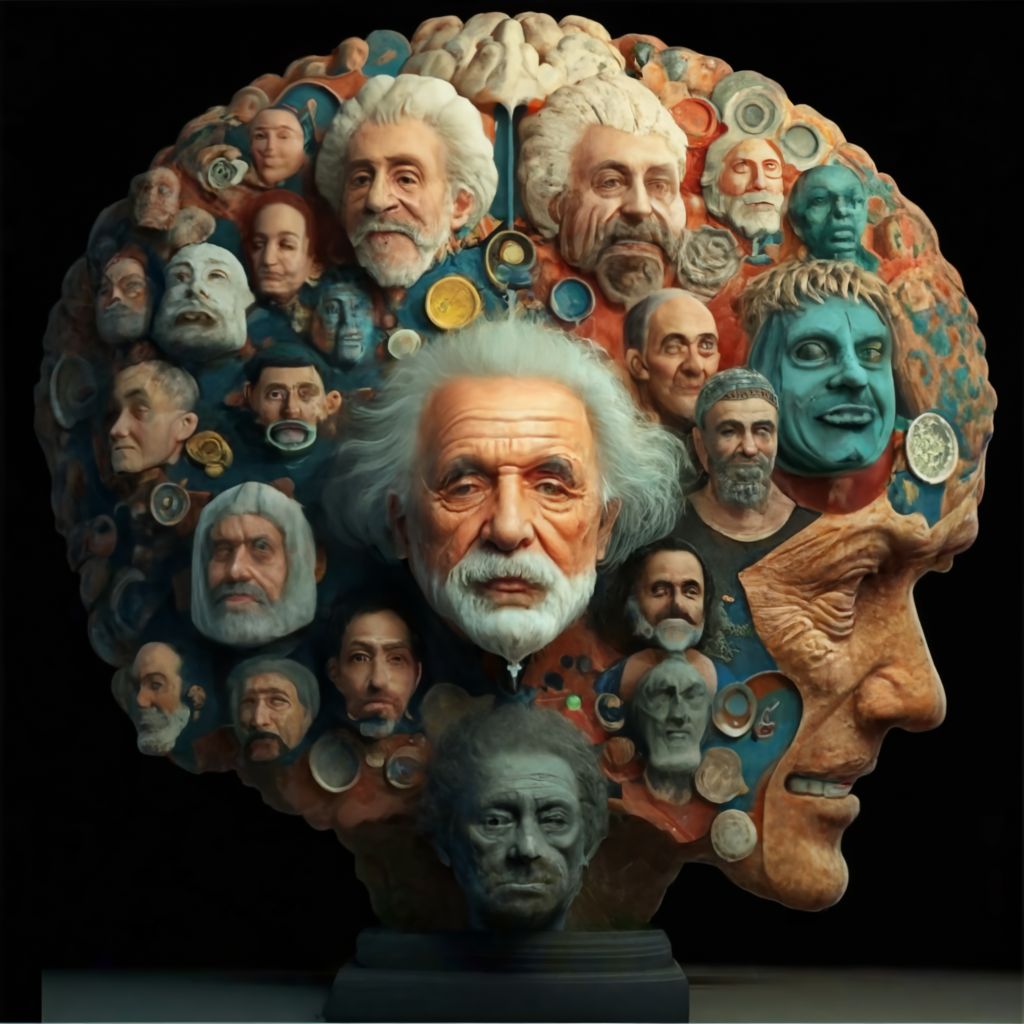
AI assisted picture: Board of Internalized Characters. The large figure expresses the internalized inner leader
Such a theoretical background in which the "social self" of the individual consists of internalizations of influential figures arranged in a hierarchical order, can perhaps explain processes in the author's creative process, as a process influenced by the dynamics of such an internalized hierarchy of figures in the writer's soul, which we called as mentioned in the metaphor "directorate of internalized characters" or "the board of the internalized characters".
Below we will detail more:
Within the board of characters there is a hierarchy of internalized characters: there is a hierarchical arrangement of internalized characters, where one or more characters are the most influential in shaping the attitudes, feelings and behavior of the individual. This may include parents, teachers, peers, or other significant people who have profoundly influenced the individual's socialization process.
The influence of the internalized figures: the attitudes, feelings and behaviors of individuals are more influenced by the internalized figures at the top of their hierarchy and especially by those of the internal leader or leaders. These characters shape the writer's perceptions, values and beliefs, which he recognizes as his own positions and as perceptions arising from him, since he is usually unaware of the activities of the internalized characters.
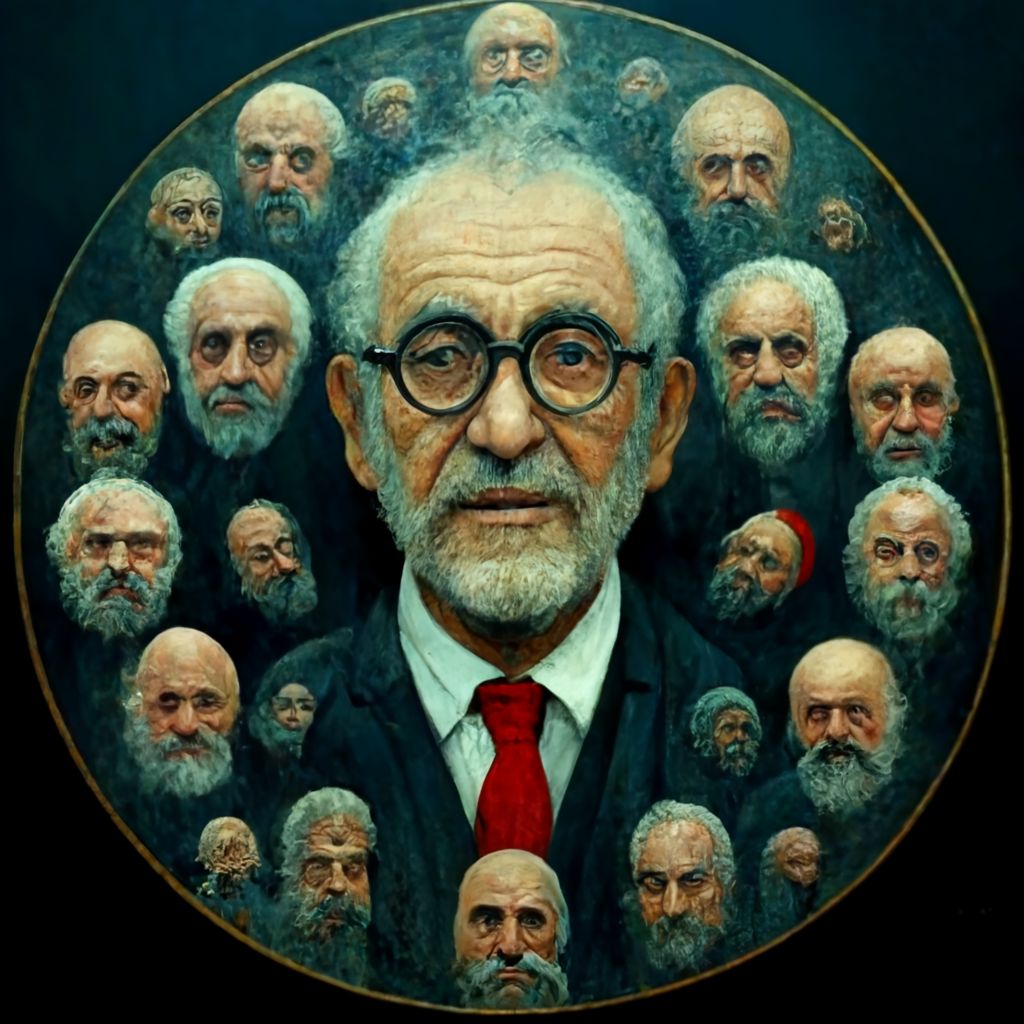
AI assisted illustration about the array of internalized characters, their size in the illustration reflects the degree of their influence
And so the theory presented above actually assumes that the creative process of a writer may be significantly influenced by a "hierarchy of internalized figures" derived from important figures in his life, but there may also be other figures from different sources and even a schematic figure or figures representing the subculture in which the writer lives and finally even the self-representations of the person behind the writer himself from different periods of his life.
All of these are found and represented in the board of internalized characters that builds the social self of the person, in our case the writer. This hierarchical structure forms part of what is called the "social self" of the writer.
And so this theory can explain the processes involved in writing a book:
Inspiration and motivation: The top figures in the hierarchy, or the "leader(s) self (selves)", can be sources of inspiration for the writer. These may include past mentors, favorite authors, or influential figures in the author's life whose ideas, styles, or attitudes resonate deeply with the author. This influence shapes the writer's initial motivation and the topics he is drawn to explore in his writings.
Character and Plot Development: When the writer creates characters and plots, he may unconsciously draw from the attitudes, feelings, and behaviors of his internalized characters. This process is usually unconscious; The writer may think that these works are purely imaginary or original, when in reality, they are a fusion or reflection of the characteristics of the internalized characters. As we will see later this is very evident in the work of Marcel Proust.
Conflict resolution and narrative dynamics: the interaction between the various internalized characters can affect the dynamics within the story. For example, if the author features a particularly strict teacher as a dominant character, this may influence him to create a similarly authoritative figure in his book, or it may affect how he resolves conflicts within his narratives.
The attitude and tone of the writing: The general attitude and tone of the book can also be a reflection of the dominant internalized characters. If the key characters are optimistic, nurturing, or cynical, these traits can permeate the author's writing style and the themes he explores.
Revising and critics: The process of revising a manuscript may also include a mental dialogue with these internalized characters. The writer may imagine a dialogue with a critical teacher, a supportive colleague, or a respected author and this may influence the way in which he revises and refines his manuscript.
Essentially, the writer does not just create from an isolated self-representation but engages in a complex interaction with a pantheon of internalized characters in his character directorate, each of which contributes to the creative process in different ways. This can lead to a richer, more nuanced work, as the writer negotiates the inner landscape, influences, and inspirations in his cast of characters.
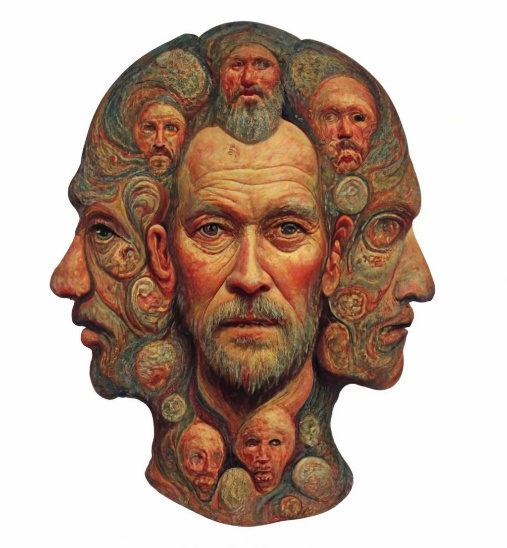

An illustration with the help of AI: The board of internalized characters that builds the social self, their size in the illustration reflects their influence
We note that the theory according to which the writer's social self consists of internalized characters arranged in a hierarchical manner can be useful in dealing with and overcoming a writer's writing barrier.
This might help:
Identifying the source of the blockage: By recognizing [independently or with the help of a loved one or therapist] that his attitudes, feelings and behaviors – including his creative expressions – are influenced by internalized characters, a writer may be able to locate the source of the blockage. For example, if a critical or discouraging character from his past dominates the hierarchy of his character board, this can cause self-doubt or creative inhibitions.
Rearranging the hierarchy: After identifying the source of the blockage, the writer can try after becoming conscious [at least partially] to rearrange to some extent the hierarchy of internalized characters. This may involve deciding to mentally "lower" the influence of overly critical figures and "promote" more supportive or creatively inspiring figures. The writer will often need self-awareness sometimes while isolating himself and looking inward or help from the outside in order to change the internal dynamics that stifle his creativity.
Dialogue with internalized characters: If they become at least partially aware, writers can conduct imaginary dialogues with their internalized characters to deal with the creative impasse. For example, they may confront in their imaginations a discouraging teacher figure to argue against the figure's limiting beliefs, or they may seek encouragement from another internalized figure who believes in their ability and give it a larger place in their inner world.
Using the internal conflict as material: the dynamic between the internalized characters and themselves can serve as rich material for writing. If a writer recognizes that his block stems from an internal conflict – for example, between a desire to innovate and a fear of failure inspired by various characters – he can use this conflict as a thematic element in his work, thus turning his struggle into a narrative investigation.
Creative role-playing: Writers can also try to temporarily adopt the point of view or style of a particularly influential figure in their hierarchy, who may offer a new angle on the work. Such role-playing can provide new insights or new methods of storytelling that can help break through the blockage.
Therapeutic writing practices: Engaging in reflective writing exercises that focus on these internalized characters can be therapeutic and creatively liberating. For example, writing a letter to a dominant inner figure explaining current creative challenges, or writing a story in which characters play these characters to work through their influences and become more aware of them.
By using the theoretical background we offer, writers can not only better understand the psychological roots of their creative blocks, but also actively work on restructuring their internal landscape to foster an environment more conducive to creativity.
This approach adds a deeper psychological toolbox to the more traditional methods of overcoming a writing block, such as changing routines, setting small, manageable goals, or switching projects temporarily.
We note that the figure of the leader self standing at the top of the hierarchy in the management of internaalized characters is dominant and may even lead us to censor what will enter the internalized board. The "leader self " as a dominant figure at the top of the hierarchy in the directorate of internalized figures plays, in our view, a decisive role both in shaping the writer's creative output and in determining the development of his creative process. This is how the leader self affects the writing process and the way in which the management of the internalized characters may change as the author deepens the plot and characters of his novel:
Influence on the writing process:
Censorship and authority: it is possible and the leader self can act as a gatekeeper, deciding which ideas are allowed to surface and which must be suppressed. This may include censoring ideas that the writer feels are too bold, controversial, or deviate from their usual style, or conversely it may include themes and narratives that encourage and align with the leader self's own values and perceptions. This selective permission can significantly shape the content and direction of the novel.
Guidance on style and substance: The leader self may also dictate the writing style – whether it is complex or simple, ornate or prosaic. He can enforce a certain consistency in the voice and tone of the novel, steering the narrative to align with his own dominant attitudes and beliefs.
Emotional and Ideological Influence: Because the protagonist is the product of a character or characters associated with the most influential experiences in the writer's life, he often embodies the writer's deepest fears, prejudices, ambitions, and ideologies. These entrenched elements can color the narrative, influencing everything from character development to plot dynamics.
We will also note that as the writer deepens and deals intensively with the plot of his novel and his characters, the library of internalized characters can undergo significant changes:
Expansion and Reorganization: New experiences, or interactions while writing with a variety of other craft writers and critics, can introduce new characters into the hierarchy or change the influence of existing ones. This may lead to a reevaluation of certain ideas or a change in narrative direction based on new influences.
Internal conflict and resolution: As characters and plot elements develop, they may challenge the writer's existing internal hierarchy. For example, creating a sympathetic character who embodies values that are contrary to those of the leader self, a character who becomes more and more internalized during an intense literary engagement with him may lead to an internal conflict. Resolving these conflicts can modify the most dominant internalized characters, thus influencing the development of the novel.
Reflection and self-discovery: The deep involvement required to create complex characters and plots can lead to greater self-awareness and observation for the writer. This introspection may reveal previously unrecognized influences of the character board or lead to a deliberate reshaping of the hierarchy to foster greater creative freedom or greater narrative authenticity.
Incorporating new insights: As the novel progresses, insights gained from exploring different perspectives through characters can lead to the integration of new attitudes and beliefs in the writer's mind, which may moderate the role of the leader self or at least diversify the influences that guide the creative process.
Essentially, the leader self limits and alternatively facilitates the creative process through his roles as a censor on the one hand and as a guide on the other. However, it is possible that the act of writing itself, being intense and prolonged, can often change this hierarchy, and lead to dynamic interrelationships between the writer's developing self-representation and the developing narratives of the novel's characters that are internalized in the character directory and can even rise in the hierarchy.
This process can be both challenging and enriching, and drive the writer's creative growth.
We will now ask whether there can be a subgroup or subgroups of the characters of the novel and the representation of the writing writer [as distinct from the representation of his normal self as a human being] within the directorate of internalized characters.
We hypothesize that within the board of characters internalized in the soul of the writer, there can exist subgroups that play specific roles or represent distinct influences on the writer's creative process. These subgroups can be seen as clusters of internalized characters who share common traits, influences or functions in the writer's life and work.
This is how such subgroups can exist and function:
Types of subgroups within the Writers Guide:
Creative inspirations: this subgroup consists of characters that mainly inspire creativity and original thinking in the writer. They may include favorite writers, artists, or even fictional characters whose works or qualities have left a lasting impression on the writer.
Critical Voices: Comprised of characters who embody criticism and self-doubt, this subgroup can include former teachers, peers, or even representations of the self who challenge his ideas and output. These data may push the writer to constantly improve his work.
Emotional Support: This subgroup includes characters who provide emotional grounding and support. They can be close family members, friends or mentors whose encouragement and belief in the writer's abilities help preserve his motivation and resilience through the challenges of the creative process.
Ethical or moral guides: These characters represent the writer's moral compass, often influencing the thematic depth and ethical dimensions of their narratives. They may stem from influential adults early in the writer's life, spiritual leaders or philosophers the writer admires.
Influence and dynamics of subgroups:
These subgroups can affect the writing process in different ways:
Balancing creative tensions: The interaction between subgroups, such as creative inspirations and critical voices, can create a productive tension that enhances the creative process. The push and pull between generating ideas and critically evaluating them can lead to deeper and more polished writing.
Narrative Development: Different subgroups can affect different aspects of narrative development. For example, emotional support characters may help a writer explore more vulnerable subjects, while ethical guides can shape the moral dilemmas characters face.
Change over time: As a writer ages or their circumstances change, the composition and influence of these subgroups may change. New experiences can add characters to a subgroup or move characters from one subgroup to another, reflecting the writer's evolving perspectives and priorities.
Conflict and Resolution: Conflicts between such subgroups can mirror the internal conflicts within a novel, and provide a rich source of material that can be woven into a narrative. How a writer resolves these internal conflicts can have a profound effect on his creative output and personal growth.
By understanding and perhaps even mapping these subgroups within the writer's directory of internalized characters, [sometimes with the help of therapists] writers can gain insight into their creative processes and psychological makeup. This awareness can empower them to harness, balance, or modify the influences of these subgroups to increase their creativity and the depth of their literary work.
Let us recall that the board of internalized figures consists of "secondary selves" which include, among other things, the following types: a) a variety of "self-representations" that originate from attitudes and feelings towards the self and its representations in different periods of life: b) internalized representations of "subculture" [subculture refers to to social influences in the environment in which the person lives and are not necessarily related to a particular person].
Writers can sometimes return from relative dominance in the character hierarchy of the current self representation to a previous self representation, especially in writing processes that include biographical elements [see below the passage in which Proust reports that dipping the Madeleine cake in the cup of tea brought him back to a flood of childhood memories] or in creative processes whose heroes are young and old. The author can give his younger self-representation more space in order to show empathy and understanding to his relatively young protagonist.
In addition, we note that the representation of the subculture is important in influencing the content of the writing, its form and expression.
It is also possible that when the author invests himself in the creative process, a figure of the "author's self" is created in the board of characters with the consent of the previous inner leader and alongside him becomes a leader in the board of characters during the writing of the book or novel or as we will see later in the subgroup or groups in the board of characters related to the book the author is working on.
Such "writer's selves" can remain in the directorate of internalized characters for a long time even after writing the book or alternatively go down the hierarchy and even pass away after writing.
Many writers have drawn inspiration from their families and influential figures in their lives, and have woven these relationships and their influences into their literary works. Here are some notable examples:
Leo Tolstoy – In his autobiographical trilogy, Childhood, Boyhood, and Youth, Tolstoy explores his early experiences and family dynamics. His later novels, such as War and Peace, also reflect the influences of his aristocratic upbringing and wider Russian society.
Virginia Woolf – Woolf wrote a lot about her family in her essays and fiction. Her novel "To the Lighthouse" particularly reflects her family experiences, with characters and settings inspired by her childhood summers.
Maya Angelou – Angelou's series of autobiographical books, starting with “I Know Why the Caged Bird Sings”, takes an in-depth look at the influence of her family and key figures in her early life. These works detail her struggles and the moments of influence that shaped her as a writer and activist.
James Baldwin – Baldwin's essays and novels often delve into his complex family relationships and the influence of his stepfather. His works also often discuss the figures who inspired him, including several key literary and civil rights figures.
Franz Kafka – Kafka's troubled relationship with his father is well explored in his letter known as "A Letter to His Father", where he articulates how his father's domineering personality affected his writing and self-perception.
Mark Twain – Twain's autobiographical writings, such as “Life on the Mississippi”, include vivid descriptions of his family, especially his mother, whom he credits with shaping his sense of humor and outlook on life.
Louise Erdrich – Many of Erdrich's novels are inspired by her native American heritage and family history. She combines personal and family narratives in her books, such as the "Birchbark House" series, inspired by her family's stories and the history of the Ojibwa people.
And finally Marcel Proust, about whom we will expand later – Proust's monumental work, "In Search of Lost Time", is autobiographical and deep, and relies to a large extent on his family and social circle. The characters in his novels are often based on his relatives and acquaintances.
These authors not only reflect on their family relationships, but also highlight how these dynamics affected their broader worldview and their literary works.
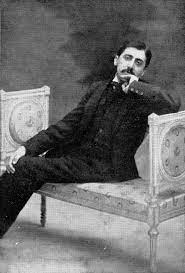

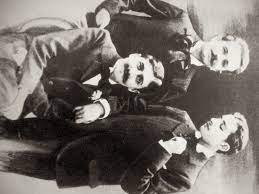
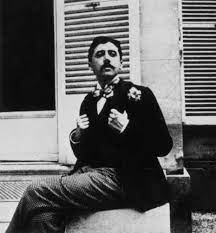
Marcel Proust is known for his profound exploration of memory, identity and relationships in his magnum opus, “In Search of Lost Time” (originally “À la recherche du temps perdu”), often considered one of the greatest literary works of the 20th century. The novel spans seven volumes and meticulously delves into the intricacies of social life, love and family, largely drawn from Proust's own experiences.
Family and personal influences:
Proust's family played a significant role in his life and work. His deep connection to his mother, Jean Weil Proust, who was of Jewish origin, is particularly striking. His relationship with his father, Adrien Proust, a well-known pathologist and epidemiologist, was more complex. This family dynamic is reflected in the relationships between his characters.
For example, the narrator's mother in "In Search of Lost Time" is a comforting presence, reflecting Proust's own closeness to his mother. Conversely, his father's rigid and scientific approach to life stands in stark contrast to Proust's sensitive and artistic temperament, a conflict that echoes through the narrator's interactions with his own family.
Influential figures:
Beyond his family, Proust was influenced by a variety of key figures in the French art and culture scene. These relationships were often charged with the same intensity and introspection that characterized his family ones. For example, the character of Charles Swann – a man of Jewish origin who assimilates into aristocratic French society – is partly based on some of Proust's acquaintances who navigated similar social and cultural tensions.
Themes of memory and identity:
At the center of Proust's story is the theme of memory, and especially involuntary memory, triggered by sensory experiences such as the famous episode of the Madeleine cookie dipped in tea, which evokes a flood of memories in the narrator. This theme is intertwined in the description of his family and influential figures, which suggests that our relationships largely shape our memories and, by extension, our identity and we according to our theoretical background say that the board of internalized figures play a considerable role in this.
Reflections on social and cultural issues:
Proust's work also reflects the social and cultural changes that occurred in France during his lifetime, including the Dreyfus affair, a political scandal that divided French society. Through characters like Swann and the narrator's own Jewish background, Proust explores themes of anti-Semitism and social exclusion, themes that he was very aware of through his family and social interactions.
Proust's introspective style and his focus on the fluidity of time and memory made "In Search of Lost Time" a seminal work in the modernist canon, influencing countless writers and thinkers. His ability to draw from his personal and family experiences, and turn them into a universal exploration of human emotion and memory, continues to resonate with readers even today.
In conclusion, Marcel Proust's literary work is a profound testimony to the influence of family and social relationships on personal identity, art and memory, and makes him a central figure in the history of literature.
Marcel Proust's work is rich in characters inspired by real people from his life, although these characters are often complex rather than straightforward descriptions. Here are some key figures who influenced him and how they are reflected in his magnum opus, "In Search of Lost Time":
Charles Haas – Haas was a prominent figure in Parisian high society and is considered one of the main inspirations for Charles Swann, one of the main characters in the Proust series. Swann is portrayed as a cultured, yet somewhat tragic figure, struggling with his social identity and unrequited love, reflecting Haas's own complex social status and relationships within the French aristocracy.
Elisabeth, Countess Garpolha – The countess was known for her beauty and elegance, which left a lasting impression on Proust. She inspired the character of the Duchesse de Garmentes, who was presented as the ultimate figure in high society, admired and feared for her wit and status. The Duchess is a central figure in the social circles the narrator aspires to join, symbolizing the seduction and superficiality of the aristocracy.
Montesquieu-Pazensac, Robert de – Esthetician and Gendren, Montesquieu was another model for the character of the Baron de Charlus. Charlus is a complex character, reflecting both his refined taste and Montesquieu's hidden weaknesses, including his homosexuality, which Proust explores with sensitivity and depth, especially given the prevailing attitudes of the time.
Alfred Agostinelli – Agostinelli was Proust's chauffeur and later his secretary, and became a significant personal obsession. He is considered part of the inspiration for Albertine, a central love interest in the novel. Albertine's ambiguous and sometimes stormy relationship with the narrator reflects Proust's own complex feelings towards Agostinelli.
Louise de Villemorin – A close friend of Proust, Villemorin may have influenced some of the more fleeting female characters in the series, ones that combine elements of fragility and strength, often challenging the narrator's notions of love and loyalty.
Jean Foucault – Jean was the wife of Proust's friend, Georges de Lloris, and is believed to have inspired the character of Odette de Crecy, the object of Swann's love. Odette is a central element in Swann's wayward and obsessive love, reflecting the complexities and destructive potential of the romantic relationship.
Each of these characters, while inspired by real people, is deeply embedded in Proust's rich narrative that explores themes of love, memory and identity. By fusing real-life inspirations with fictional elements, Proust created a timeless exploration of human nature that remains poignant and relevant today.
We note that Marcel Proust's family also played a central role both in his life and in his literary work, especially in his magnum opus, "In Search of Lost Time". His family members are reflected in his work, and are often used as templates for his characters and the dynamics between them.
Adrien Proust (father) – As mentioned, Marcel Proust's father, Adrien Proust, was a prominent doctor who specialized in epidemiology. He was a respected figure in the medical community, which placed the Proust family in a relatively high social status. In Marcel's work, the character of the narrator's father can be seen as a distant, somewhat imposing figure, reflecting Adrian's busy career, which often kept him away from family life.
Jean Clemens Weil (mother) – As mentioned, Jean Weil, Proust's mother, was of Jewish origin and had a profound influence on Marcel, both personally and in his writing. Her death in 1905 had a severe impact on him, which had a profound effect on his health and emotional state. In "In Search of Lost Time" the narrator's mother is a central figure of warmth, understanding and emotional support. Her presence is a significant anchor in the narrator's life, just as Jean was in Marcel's own life.
Robert Proust (brother) – Marcel's younger brother, Robert, became a doctor like their father. Although the relationship between Marcel and Robert was less prominent in his literary work, it was also characterized by the usual complexities of sibling dynamics. Robert supported Marcel's literary ambitions, although he did not always understand them.
Literary reflections:
In his novel Proust explores themes of memory, time and identity, which are deeply intertwined in his experiences with his family. His description of family relationships is detailed and full of nuances, and shows not only the love and support, but also the tensions and misunderstandings that can occur within the family.
Maternal Influence: The narrator's relationship with his mother in the novel mirrors Proust's relationship with his mother in real life. This relationship is particularly evident in the way memories are triggered, such as the famous Madeleine scene, where a simple action involving her mother brings back a flood of memories.
The father's presence: The father's presence in the novel, although less emotionally intense than the mother's, reflects the social and family expectations imposed on the narrator, similar to the expectations Proust might have felt due to his father's position in society.
Family as Social Commentary: Proust also uses his family dynamics as a lens to criticize French society at the turn of the century, particularly in terms of social type, relationships between different social classes, and the role of art and culture.
As a rule, Marcel Proust's writing reveals a deep connection to his family, and serves as inspiration and a framework for researching broader social and existential issues. His reflections on family not only enrich his narrative, but also offer a universal exploration of the impact of family relationships on identity and personal development.
Marcel Proust's writings were deeply influenced by the cultural milieu of France in the late 19th and early 20th centuries. This period was characterized by dramatic social, artistic and philosophical changes, all of which are intricately woven into his magnum opus, "In Search of Lost Time". This is how the culture of his time shaped his writings and his literary personality:
Belle Époque, a term meaning "beautiful age", was a period of peace and prosperity in France before World War I, known for its cultural flourishing and technological progress. The optimism of the era, its focus on art and aesthetics, and its social rituals had a profound effect on Proust's depiction of aristocratic life, the social manners, and the salons that form the background for much of his narrative.
Artistic movements:
Proust lived in a transformative period in art, witnessing transitions from realism and naturalism to impressionism and then to modernism. He was particularly influenced by the Impressionists' focus on subjective experiences and fleeting impressions, evident in his detailed and nuanced descriptions of moments and sensations.
His narrative technique, which captures the flow of thoughts and memories, parallels the artistic attempt to describe life beyond the constraints of traditional structure and form.
Literary scene:
The literary milieu of Proust's time included figures such as Gustave Flaubert, whose focus on psychological depth and style resonated with Proust. Furthermore, the Dreyfus affair, a major political scandal, divided the people and the literary community, and influenced Proust's views on social justice and hypocrisy. These themes find their way into his works, and examine the moral and ethical dilemmas of his time.
Social and philosophical ideas:
Proust's time was characterized by the appearance of new philosophical ideas, mainly from thinkers like Henri Bergson, whose theories on memory and time influenced Proust's conception of involuntary memory and the subject of lost time – as a central element in his narrative. Furthermore, the Freudian ideas of the unconscious and the complexity of human passions emerged during Proust's lifetime, echoing his deep studies of love, jealousy and social ambition.
The tension between public propriety and private desires in Proust's society, especially in relation to homosexuality, is a significant theme in his work. Proust, who was homosexual, subtly integrated these themes into his books. Figures such as the Baron de Charlots explore these conflicts, highlighting the struggles and social pressures faced by those who deviated from the normative sexual behaviors of the time.
Jewish identity:
As a man of partial Jewish descent, Frost was sensitive to the nuances of Jewish identity in predominantly Catholic France. This awareness is reflected in his multi-nuanced portrayal of figures like Charles Swann, who navigates his Jewish identity in a complex social landscape, reflecting broader issues of anti-Semitism and integration.
The influence of technology and modernity:
The period was characterized by rapid technological changes, including the rise of automobiles and telephones, which are depicted in Proust's work as symbols of modernity and change, affecting social interactions and the pace of life.
In general, Proust's character and writings are a product of his cultural context, reflecting the complexities and contradictions of his time. His ability to capture the essence of the Belle Epoque, while critically engaging with its values and norms, made his work an essential historical and literary document.
Marcel Proust's writings, although focused mainly on social and psychological issues, also intersect with the political climate of his time. A number of political figures and events from the late 19th and early 20th centuries likely influenced him directly, either through personal encounters or indirectly through the wider social effects they had. Here are some key characters and contexts:
Georges Clemenceau
Clemenceau was a leading figure in French politics, and served as Prime Minister of France at critical times, including the end of the First World War. He was known as "The Tiger" due to his strong political stance, and was one of Alfred Dreyfus' prominent supporters during the Dreyfus Affair.
This affair, which divided French society into the Dreyfusers (those who supported Dreyfus) and the opponents of Dreyfus, was a significant event in Proust's life and is mentioned in his work, reflecting his own sympathy towards the Dreyfus family and highlighting the anti-Semitic and factional politics of that time.
Alfred Dreyfus
Although not a political figure per se, the wrongful conviction of Alfred Dreyfus for treason had a profound effect on French society and politics. As mentioned, Proust was deeply interested in the Dreyfus case; His position and the wider implications of the affair on justice, anti-Semitism and media influence are woven into the subtext of his literary work. The affair illustrated the deep divisions in French society and the capricious nature of justice, themes that resonated in Proust's investigation of social hypocrisy.
Jaures was a socialist leader known for his support of workers' rights and his opposition to the First World War. While Proust was not overtly political in his writings, the ideological battles of the time, including debates about socialism and capitalism, form the backdrop against which his characters navigate their lives. The social criticism implied in Proust's work may reflect the influence of political debates and figures such as Jaures.
Raymond Poincaré
As President of France during most of World War I, Poincaré was a symbol of French nationalism and resilience. While Proust spent the war years mostly in seclusion due to his frail health, the war itself had a profound effect on him and shaped the social landscape into which his later volumes emerged. The themes of loss, change and decay of the old social order can be seen in his creation as a reflection of the impact of the war on European society.
The political environment of the Third Republic:
The political environment of the French Third Republic, characterized by instability, many scandals and the struggle between monarchists, republicans and anarchists, provided a rich fabric against which Proust set his narratives. The shifting loyalties and role of the bourgeoisie in politics are reflected in the way his characters interact with each other and in their social distinctions.
While Proust's work is less about political activism and more about introspection into human nature and society, these political figures and the events surrounding them influenced the moral and ethical landscape of his characters and theories. His subtle inclusion of political commentary offers a meticulous reflection of the complexities of his time.
We will now summarize how each character in Marcel Proust's book was influenced by a real character or a combination of characters in his real life. Here are ten notable examples, including the fictional characters and their real-life inspirations:
Charles Swann
Fiction: Charles Swann
Real life inspiration: Charles Haas
Details: A well-known Jewish socialite and high-society art collector in Paris, Charles Haas was a model for Swann, who shared his charm, sophistication and tragic love story.
Fiction: Odette de Crecy
Real life inspiration: Laura Hyman
Details: Laura Heyman, a courtesan and prominent figure in Parisian salons, inspired the character of Odette, who is Swann's mistress and later his wife.
Baron de Charlus
Fiction: Baron de Charlus
Real life inspiration: Robert de Montesquieu
Details: A French poet, genderqueer and esthetician, Robert de Montesquieu served as a prototype for the aristocratic and eccentric Charles.
Fiction: Gilbert Swann
Real-life inspiration: Marie de Benardaki
Details: Gilbert, daughter of Swann and Odette, is based on Marie de Benardaki, whom Proust knew as a child and had a crush on.
Albertine Simont
Fiction: Albertine Simont
Real life inspiration: Alfred Agostinelli
Details: Alfred Agostinelli, Proust's chauffeur and secretary, became Albertine, reflecting Proust's complex emotions and homosexual passions.
Fiction: Madame Verdorin
Real-life inspiration: Madame Armand de Cailla
Details: Madame Armand de Caillebet, a prominent salon hostess, inspired the character of Madame Verdorin, known for her influential salon.
Robert de Saint-Loup
Fiction: Robert de Saint-Loup
Real-life inspiration: Gaston de Quailha and Bertrand de Fenlon
Details: Saint-Loup is a complex character based on Proust's close friends, Gaston de Quaille, a nobleman and soldier, and Bertrand de Fenlon.
Fiction: The Duchesse de Garmentes
Real-life inspiration: Elisabeth de Clermont-Tonner and Genevieve Halévy Bizet-Strauss
Details: The duchess embodies characteristics of both the elegant Elisabeth de Clermont-Tonner and the hostess of the salon Genevieve Halloy Bizet-Strauss.
Alastair
Fiction: Alastair
Real-life inspiration: A number of artists, including Claude Monet and James Whistler
Details: Alastair, a talented painter, is a combination of real artists such as Claude Monet and James Whistler, reflecting Proust's admiration for their work.
Fiction: Françoise
Real life inspiration: Céleste Albaret
Details: Céleste Albaret, Proust's devoted housekeeper and confidante, inspired the character of Françoise, the narrator's loyal and receptive servant.
These characters illustrate how Proust intricately wove his personal experiences and acquaintances into the rich fabric of his literary masterpiece.
We have therefore reviewed the case of Marcel Proust while aiming that the set of characters mentioned above shaped his board of characters and possibly subgroups in this board that are related to his monumental work and greatly influenced it.
That's it for now,
yours,
Dr. Igor Salganik and Prof. Joseph Levine
 Prof. Joseph Levine, M.D. is an emeritus associate professor in the Division of Psychiatry, Faculty of Health Sciences, Ben Gurion University in Israel. Prof. Levine is a certified psychiatrist with clinical experience in controlled trials of adult psychiatric disorders and in psychotherapy. He was awarded a NRSAD independent investigator grant for the study of Creatine Monohydrate in psychiatric disorders -- mainly Schizophrenia. He resides and treats patients in Tel Aviv and all of central Israel.
Prof. Joseph Levine, M.D. is an emeritus associate professor in the Division of Psychiatry, Faculty of Health Sciences, Ben Gurion University in Israel. Prof. Levine is a certified psychiatrist with clinical experience in controlled trials of adult psychiatric disorders and in psychotherapy. He was awarded a NRSAD independent investigator grant for the study of Creatine Monohydrate in psychiatric disorders -- mainly Schizophrenia. He resides and treats patients in Tel Aviv and all of central Israel.
Leave a comment